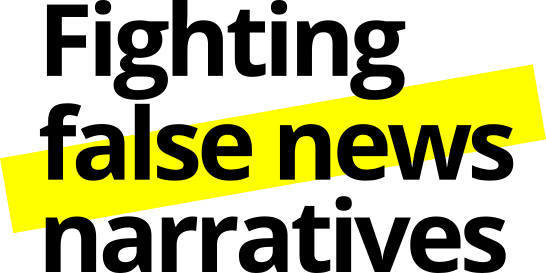Social networks are a great tool for information, but an even better one for misinformation. What is the reason for this?
First of all, the reason for this is the remarkable reach of the audience. The biggest social networks and so-called online giants (Facebook, Google, YouTube, Twitter, etc.) are the largest media platforms in media history. Facebook alone has over 2.4 billion users, YouTube 2 billion, Instagram 1 billion, Twitter over 300 million, and so on. Most of them have options for open publishing, so you don’t have to be a registered user to see something on their platforms, which means they provide an instant audience of over 4 billion people with internet access. Compared to the audience that the most influential media had before them, these are incredible numbers, which confirm that they are really media giants.
The contents of these platforms are published instantly and almost without restrictions, and the freedom of publishing is great. Some of them, such as Facebook, have some automated control mechanisms, such as algorithms that recognize human nudity content and prevent it from being published. However, the dominant part of the content can be published without hindrance, and the removal of the prohibited content is done “post-festum”, i.e. after the content has been reported but can already be seen and saved by millions of users. Unfortunately, that was the case with the terrorist attack in New Zealand on March 15, 2019, when 51 people were shot in two mosques in Christchurch. The video of these attacks, which the killer broadcast live on Facebook, can still be found on numerous social networking profiles. Debunking misinformation and other related content requires time, coordination and persistence, which often leaves enough time for disinformation to accomplish its intended purpose. In November 2019, Facebook announced that 3.4 billion fake profiles had been removed from their platform in the last 6 months. However, the effect of these activities is questionable primarily due to the fact that these profiles are easily replaced by new ones whose detection will again take a considerable time.
This is much like the ancient Greek myth of Hydra, the water monster with many heads, to whom if you cut off one head off, two new ones grow. In any case, these platforms for the time being prove to be excellent logistics for an easy dissemination of information, which are then difficult to remove. In other words, social networks easily become incredibly effective propaganda machines. Yes, these are probably the most powerful propaganda machines in the history of mankind. Through their reach, misinformation content is easily disseminated and reproduced, making them even more frustrating when the user has malicious intent to publish and disseminate a certain content. The rise in intolerance, hate crimes and hate speech are directly linked to the increasing use of the social networks. At least one mass crime and genocide has been committed with the considerable use of the social networks, such as the one in Myanmar. Various organizations and governments are still working on building mechanisms to protect against similar abuses.
Marshall McLuhan, one of the leading media theorists, says that “the medium is the message”, that is, the medium itself greatly influences what content is circulated and disseminated through that medium. In that sense, the social network is a media platform that favors the so-called interactive content, that is, content that causes a strong involvement and interaction with the content and other users (so-called engagement). Social networks encourage interactivity and inclusion, and often cause addiction. As such, the content that results in the biggest engagement is the content that is aimed at our core urges, fears and passions. A certain provoking content or extremist message has far more potential for “engagement” than some useful cake recipe. Exactly this content is then favored by the social networking algorithms and more often displayed on the users’ profiles. While they often encourage such irritating content, it has been proven that they disseminate more easily through the social networks, especially Facebook and Twitter. Lies travel a lot faster through online channels than do the facts.
It should also be noted that often these social networks prove to be amoral platforms that do not take into account the ethical dimension of the communication. Facebook’s CEO, Mark Zuckerberg, justified this decision of not following the ethical principles in determining what might be published on Facebook with the concern for freedom of speech in his recent address. According to him, Facebook will continue to advertise content that is not fact-checked in the form of paid advertising. By doing so, interested political entities will be able to publish content that is politically relevant to them, without taking into account the facts or perhaps the harmful effects of their publication. This lack of application of the ethical principles for publishing and giving information is truly worrying and leaves an open door for many abuses. Mechanisms that may not be controllable, but which will establish clear responsibility for the online giants and their platforms, seem to be unavoidable in the very near future.
Where does Macedonia stand in this?
Macedonia is a good example of how the media evolves without any protective oversight and becomes a tool that can have numerous harmful consequences. The social networks, as well as many traditional and new media before them, went through the three phases of (a) popularization, (b) commercialization, and (c) politicization. As their influence grew enormously and the influence of television and the press began to decline, the unregulatedness and openness of these networks was quickly used for political propaganda and for various manipulations. From a secondary platform for pre-publishing content aimed for television programs, they are now the primary place to run the dirty part of the political activities and campaigns. Various techniques of coordinated dissemination of misinformation for propaganda purposes, running black campaigns, spreading appropriate political narratives, pressures on individuals and groups, as well as many other manipulative activities, have completely shifted to social networks. The almost non-existent individual and legal responsibility is driving these networks to continue to be more abused than used for positive and open communication.
The social networks are also often used to test certain provocative or extremist-nationalist narratives in order to examine public reactions, or indirectly to achieve certain political effects through anonymous indirect or so-called “proxy supporters”. In any case, they prove to be powerful tools for political propaganda, and this efficiency motivates both big political parties and smaller groups to “innovate” and test different manipulation techniques, which anyhow is a worrying process.
The potential harms and dangers that social media has regarding misinformation and hate speech are really serious. Long-term work and education is needed to reduce the harmful effects they can cause. Long-term investments in education and some form of co-regulation are necessary to enable the benefits of these new technologies and platforms to far outweigh their adverse sides and effects.
Sead Dzigal









